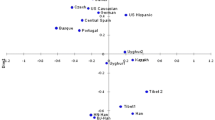Abstract
In previous studies, the highest frequencies (16%) of the CCR5 Δ32 deletion have been found in populations of Finno-Ugric origin. We here report a high CCR5 Δ32 frequency (15%) in another Finno-Ugric populations, the Estonians. The highest frequency (18%) was found on the geographically isolated Estonian island of Dagö. We examined 504 healthy unrelated individuals of Estonian nationality, whose grandparents were born in Estonia. The polymerase chain reaction assay was performed and the amplified products were digested with EcoRI.
Similar content being viewed by others
References
Samson M, Labbe O, Mollereau C, Vassart G, Parmentier M. Molecular cloning and functional expression of a human CC-chemokine receptor gene. Biochemistry 1996; 35: 3362-3367.
Rothenberg ME, Zimmermann N, Mishra A, et al. Chemokines and chemokine receptors: Their role in allergic airway disease. J Clin Immunol 1999; 19(5): 250-265.
Maho A, Bensimon A, Vassart G, Parmentier M. Mapping of the CCXCR1, CX3CR1, CCBP2 and CCR9 genes to the CCR cluster within the 3p21.3 region of the human genome. Cytogenet Cell Genet 1999; 87: 265-268.
Samson M, Soularne P, Vassart G, Parmentier M. The genes encoding the human CC-chemokine receptors CC-CKR1 to 5 are clustered in the p21.3-p24 region of chromosome3. Genomics 1996; 36: 522-526.
Libert F, Cochaux P, Beckman G, et al. The ccr5 mutation conferring protection against HIV-1 in Caucasian populations has a single and recent origin in Northeastern Europe. Hum Molec Genet 1998; 7: 399-406.
Samson M, Libert F, Doranz B, et al. Resistance to HIV-1 infection in caucasian individuals bearing mutant alleles of the CCR-5 chemokine receptor gene. Nature 1996; 382: 722-725.
Ansari-Lari MA, Liu X-M, Metzker ML, Rut AR, Gibbs RA. The extent of genetic variation in the CCR5 gene. (Letter) Nature Genet 1997; 16: 221-222.
Martinson JJ, Chapman NH, Rees DC, Liu Y-T, Clegg JB. Global distribution of the CCR5 gene 32-basepair deletion. Nature Genet 1997; 16: 100-103.
Carrington M, Kissner T, Gerrard B, Ivanov S, O'Brien SJ, Dean M. Novel alleles of the chemokine-receptor gene CCR5. Am J Hum Genet 1997; 61: 1261-1267.
Alkhatib G, Ahuja SS, Light D, Mummidi S, Berger EA, Ahuja SK. CC chemokine receptor 5-mediated signaling and HIV-1 co-receptor activity share common structural determinants. Critical residues in the third extracellular loop support HIV-1 fusion. J Biol Chem 1997; 272(32): 19,771-19,776.
Paxton WA, Liu R, Kang S, et al. Reduced HVI-1 infectability of CD4 + lymphocytes from exposed-uninfected individuals: Association with low expression of CCR5 and high production of beta-chemokines. Virology 1998; 244: 66-73.
Zimmerman PA, Buckler-White A, Alkhatib G, et al. Inherited resistance to HIV-1 conferred by an inactivating mutation in CC chemokine receptor 5: Studies in populations with contrasting clinical phenotypes, defined racial background, and quantified risk. Molec Med 1997; 3(1): 23-36.
Carrington M, Dean M, Martin MP, O'Brien SJ. Genetics of HIV-1 infection: Chemokine receptor CCR5 polymorphism and its consequences. Hum Mol Genet 1999; 10: 1939-1945.
Leboute APM, de Carvalho MWP, Simões AL. Absence of the Δccr5 mutation in indigenous populations of the Brazilian Amazon. Hum Genet 1999; 105: 442-443.
Stephens JC, Reich DE, Goldstein DB, et al. Dating the origin of the CCR5-del32 AIDS-resistance allele by the coalescence of haplotypes. Am J Hum Genet 1998; 62: 1507-1515.
Huang Y, Paxton WA, Wolinsky SM, et al. The role of a mutant CCR5 allele in HIV-1 transmission and disease progression. Nat Med 1996; 2(11): 1240-1243.
Li C, Yan YP, Shieh B, Lee CM, Lin RY, Chen YM. Frequency of the CCR5 delta 32 mutant allele in HIV-1-positive patients, female sex workers, and a normal population in Taiwan. J Formos Med Assoc 1997; 96: 979-984.
Sambrook J, Fritsch EF, Maniatis T. Molecular cloning: A laboratory manual. Cold Spring Harbor, NY: Cold Spring Harbor Laboratory, 1989; 9.1-9.62.
Liu R, Paxton WA, Choe S, et al. Homozygous defect in HIV-1 coreceptor accounts for resistance of some multiply-exposed individuals to HIV-1 infection. Cell 1996; 86: 367-377.
Author information
Authors and Affiliations
Rights and permissions
About this article
Cite this article
Kalev, I., Mikelsaar, AV., Beckman, L. et al. High frequency of the HIV-1 protective CCR5 Δ32 deletion in native Estonians. Eur J Epidemiol 16, 1107–1109 (2000). https://doi.org/10.1023/A:1010829816334
Issue Date:
DOI: https://doi.org/10.1023/A:1010829816334




